15.14 Other Respiratory Disorders
Overviews of other common respiratory disorders are discussed in this section.
Asthma
Asthma is a common chronic respiratory condition that is characterized by episodes of inflammation and edema of the airways and bronchospasms that prevent air from entering the lungs. Excessive mucus secretion can also occur, which further contributes to blockage of the airway and shortness of breath. Bronchospasms can lead to asthma attacks that can range from mild to severe and can be life-threatening. An asthma attack may be triggered by environmental factors such as dust, pollen, pet hair, or dander; changes in the weather; mold; tobacco smoke; respiratory infections; or by exercise and stress. Between episodes of asthma attacks, many individuals with asthma are asymptomatic.[1]
See Figure 15.10[2] for an illustration of how asthma affects the airways.
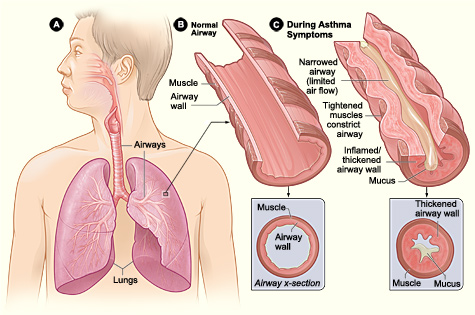
Symptoms of an asthma attack involve coughing, dyspnea (shortness of breath), wheezing, and tightness of the chest. Severe asthma attacks can be fatal and require immediate medical attention. Symptoms of a severe asthma attack include worsening dyspnea that can cause cyanotic or blue lips or fingertips, worsening wheezing, confusion, drowsiness, a rapid pulse, sweating, and severe anxiety.[3] Increasingly severe asthma that is unresponsive to treatment is called status asthmaticus. Status asthmaticus is a medical emergency that requires immediate treatment to avoid respiratory failure and death. In severe case, endotracheal intubation and mechanical ventilation is often required, along with administration of nebulizers, IV steroids, and IV antibiotics if an underlying infection is suspected.[4]
Chronic asthma is typically diagnosed by health care providers by using pulmonary function tests. Individuals with asthma are often prescribed a peak flow meter, a portable instrument used to measure air flow during forced exhalation, to help manage their symptoms. Asthma is treated by respiratory medications given via an inhaler and/or nebulizer. A nebulizer is a medical device that creates a mist for delivering respiratory medication. Inhalers may be referred to as dry powder inhalers (DPI) or metered dose inhalers (MDI). The severity of the condition, frequency of attacks, and identified triggers influence the type of medication that an individual may require. Long-term treatments for patients with severe asthma include oral and/or injectable medications.[5]
Read more information in the “Asthma” section of the “Respiratory System Alterations” chapter in Open RN Health Alterations.
Cystic Fibrosis
Cystic fibrosis (CF) is a genetic disease that causes a faulty cystic fibrosis transmembrane conductance regulator (CFTR) protein that affects the body’s cells, tissues, and glands that make mucus and sweat. People with CF have thick, sticky mucus that builds up in the lungs and digestive tract and other areas of the body. This excessive mucus blocks airways, prevents effective airway clearance, and increases the risk for respiratory infections that can cause lung damage. It also affects the pancreas, with the increased secretions preventing digestive enzymes from reaching the intestines and decreasing the body’s ability to absorb nutrients from food. The most serious complications of cystic fibrosis are respiratory exacerbations caused by lung infections.[6]
CF is an autosomal recessive disorder diagnosed through a multistep process that includes newborn screening, a sweat chloride test, genetic testing, and clinical evaluation. The sweat test detects a higher amount of chloride and sodium in the sweat of people who have cystic fibrosis. Most children with CF are diagnosed by age 2, but some are not detected until age 18 or older.[7]
Cystic fibrosis was historically a cause of childhood mortality, but survival has significantly improved because of medical advances in newborn screening, medications, nutrition, and lung transplants. Clients with certain CFTR mutations can be prescribed CFTR modulators that work to improve how the faulty CFTR protein works. Respiratory medications such as bronchodilators open and relax the airways, and mucus thinners help the client expectorate mucus. Anti-inflammatory medications, such as ibuprofen or corticosteroids, reduce inflammation caused by CF that can worsen lung disease. Antibiotics may also be prescribed intermittently or continuously to reduce the risk of infection and promote better health outcomes for clients. Lung transplants may be performed for people with severe lung disease and respiratory failure.[8],[9]
Diphtheria
Diphtheria is a preventable illness that is caused by the bacteria Corynebacterium diphtheria. This disorder predominantly affects the respiratory and integumentary systems. Due to the presence of a vaccine, cases are low in the United States. However, clients who are at risk for contracting this disease include those who have a low socioeconomic status, are not vaccinated, travel to endemic areas, or live in close quarters. Children under 12 years old are the most likely to contract this disease, but adults can suffer from this disorder as well.[10]
Diphtheria is transmitted by airborne respiratory secretions. Once inhaled, C. diphtheria produces an endotoxin that leads to inflammation in the throat of the afflicted client. This inflammation leads to the formation of a gray pseudomembrane in the throat and on the tonsils, which is a hallmark finding of this disease. The pseudomembrane will bleed if a removal attempt is made.[11] See Figure 15.11[12] for an image depicting this membrane.
![]”Dirty_white_pseudomembrane_classically_seen_in_diphtheria_2013-07-06_11-07” by Dileepunnikri is licensed under CC BY-SA 3.0 Photo showing Membrane Associated With Diphtheria](https://wtcs.pressbooks.pub/app/uploads/sites/48/2024/10/Dirty_white_pseudomembrane_classically_seen_in_diphtheria_2013-07-06_11-07.jpg)
Other common signs and symptoms of diphtheria are fever, sore throat, enlargement of cervical lymph nodes, headache, difficulty swallowing, and malaise.[13]
To confirm a diagnosis, a throat swab is taken and cultured to determine the presence of the C. diphtheria bacteria. PCR testing can also be done to differentiate between different strains of the bacteria. A complete blood count will demonstrate an elevated white blood cell count. Imaging of the chest and neck areas may indicate swelling of soft tissue.[14]
Treatment consists of antibiotics and a diphtheria antitoxin. The client is also monitored for respiratory and cardiac distress. Airway management and cardiac monitoring are necessary. Clients with diphtheria should also follow isolation precautions to prevent the spread of infection.[15]
Potential complications of diphtheria can be fatal and include inflammation of the heart, arrhythmias, and nerve inflammation, leading to weakness or paralysis. The formation of the pseudomembrane can also cause airway obstruction, necessitating the need for intubation and mechanical ventilation.
Diphtheria is preventable by vaccination. Usually, this is given in combination with vaccines for tetanus and pertussis (DTap or Tdap).[16]
Read additional information about the DTap or Tdap vaccines on the Centers for Disease Control and Prevention web page.
Mumps
Mumps is a contagious illness caused by paramyxovirus. Although once a common disease of childhood, it has become much less frequent due to vaccination. Mumps cases are generally seen in the late winter and early spring seasons. Clients at risk for contracting mumps are those who are immunocompromised, unvaccinated, traveling to endemic areas, or living in close proximity to others.[17]
The mumps virus is transmitted via contact with respiratory secretions, saliva, or fomites (inanimate objects that can spread disease to others when they are contaminated with an infectious organism). After a client is infected with the mumps virus, it will replicate in the mucosa of their upper airways. Eventually, the infection will spread to lymph nodes and result in widespread inflammation of various bodily tissues.[18]
Some clients infected with the mumps virus may be asymptomatic yet contagious to others. Initial symptoms are fever, muscle aches, malaise, and loss of appetite. This is followed by parotitis, painful swelling of the parotid salivary glands, a hallmark characteristic of this disorder. Generally, bilateral parotid glands on both sides of the mouth will become inflamed, but sometimes the swelling will be unilateral. See Figure 15.12[19] for an image of a child with parotitis due to mumps. Another common manifestation of mumps is orchitis, or painful swelling of the testes. Oophoritis, or inflammation of the ovaries, can occur in females but is rarer than orchitis. Neurological issues such as meningitis or encephalitis can also occur. Other signs of systemic inflammation, such as pancreatitis, thyroiditis, arthritis, or myocarditis, may occur but are rare.[20]
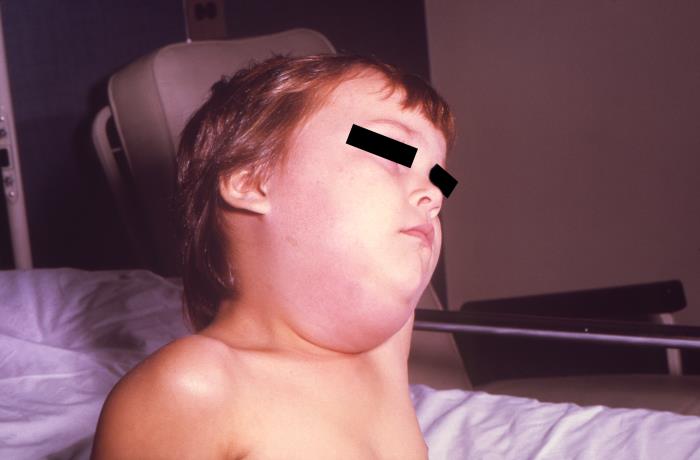
If the client presents with swelling of the parotid glands and has a known exposure to the mumps virus, a clinical diagnosis can be made. However, a swab can be taken of the mouth and undergo PCR testing to confirm a diagnosis. Additionally, blood can be drawn to screen for antibodies to the mumps virus. However, antibody and PCR tests are falsely negative in a large number of clients, so confirmation of the diagnosis can be difficult to obtain.[21]
Mumps resolves on its own with time, so only supportive care is needed such as pain medication and cold or warm compresses. Orchitis can be managed with elevation and cold compresses. Teaching clients about effective handwashing and avoiding others while ill are essential to prevent the spread of the infection to others.[22]
Potential complications can occur due to the mump virus. When mumps occurs in a pregnant client, birth defects, premature birth, low birth weight, and fetal death are possible. Deafness can also result from a mumps infection, but this complication is rare.[23]
Mumps can be prevented with the administration of the MMR vaccine.[24]
Read additional information about the MMR vaccine on the Centers for Disease Control and Prevention web page.
Pertussis
Pertussis, also known as whooping cough, is a preventable and contagious respiratory disorder caused by the bacteria Bordetella pertussis or Bordetella parapertussis. This disorder mainly affects infants and children under age five, but adults can contract pertussis as well. Clients at risk for contracting pertussis are those who are pregnant, have not been immunized, have contact with someone who is infected, or travel to an endemic region. Pertussis primarily occurs in the summer months. Even though a vaccine is available, cases are on the rise in the United States.[25]
Pertussis is spread by respiratory droplets that occur due to coughing. Once inhaled, the pertussis bacteria adhere to the respiratory tract and lead to inflammation in the lining of the mucosa.[26]
Initial signs and symptoms of pertussis are fever, rhinorrhea, and fatigue. After the fever resolves, a cough begins. The cough is followed by a strong inspiration that causes the “whooping” sound that is characteristic of this disorder. Listen to the characteristic sound using the information in the following box. The cough is more common at night and can be activated by cold air or noise. During coughing fits, the client may have excessive sweating, cyanosis, or stop breathing. When the coughing subsides, the client may vomit or experience syncope or apnea.[27]
Listen to the following YouTube video[28] for a demonstration of the sound of a whooping cough: What is That Sound? Whooping Cough.
Infants may exhibit atypical symptoms and may have a fever. Common signs and symptoms in infants are elevated respiratory rate, apnea, cyanosis, and decreased heart rate.[29]
Diagnosis of pertussis can be done by culturing secretions from the nose and throat or PCR testing. However, cultures are slow to grow and lack sensitivity. PCR testing is more reliable, but not always available. Clients who are positive for pertussis may also exhibit an elevated white blood cell count.[30]
Pertussis treatment consists of supportive care such as providing oxygen as indicated, increasing fluid intake, and suctioning secretions. Hospitalization is recommended for clients experiencing secondary infections, low oxygen levels, those who cannot eat or drink, and those who are less than one year old. The illness can be prolonged and require parenteral nutrition.[31]
Antibiotics are prescribed to prevent the spread of the condition, but depending on when they are initiated, they may not decrease the severity or length of the disorder. Due to pertussis’ high level of contagion, antibiotics are also recommended for people who have had contact with a client who is positive for pertussis. Additionally, the client must follow isolation procedures until they are no longer infectious, which is usually five days after the start of antibiotic therapy.[32]
A frequent complication of pertussis is secondary pneumonia caused by aspiration of gastrointestinal contents during coughing. Although rare, complications of the central nervous system such as seizures or bleeding into the brain may also occur. Increased pressure in the thorax and abdomen due to frequent coughing may also lead to a collapsed lung, rupture of the diaphragm, hernia formation, or rectal prolapse.[33]
Pertussis is preventable by vaccination that is typically given in combination with vaccines for diphtheria and tetanus (DTap or Tdap).[34]
Read additional information about the DTap or Tdap vaccines on the Centers for Disease Control and Prevention web page.
Pneumonia
Pneumonia is an infection of the alveoli of the lungs caused by microorganisms like bacteria, viruses, or fungi that can cause mild to life-threatening illness in people of all ages. It is characterized by inflammation and infection within the alveoli, causing them to fill with fluid or purulent material, resulting in a productive cough, fever, chills, and difficulty breathing. Pneumonia differs from chronic conditions like asthma and COPD in that it is an acute infection. It is most serious for infants and young children, people older than age 65, and clients with chronic health problems or weakened immune systems.[35],[36]
Symptoms of pneumonia include the following[37]:
- Cough, which may produce greenish or yellow mucus (often called purulent sputum)
- Fever and shaking chills
- Dyspnea (shortness of breath)
- Rapid, shallow breathing
- Sharp or stabbing chest pain that gets worse when breathing deeply or coughing
- Loss of appetite, low energy, and fatigue
Common diagnostic tests for pneumonia include sputum cultures and chest X-rays. There are several categories of pneumonia[38]:
- Aspiration pneumonia: Pneumonia that occurs when food or liquid is breathed into the airways or lungs, instead of being swallowed.
- Community-acquired pneumonia: Pneumonia that is diagnosed in someone in the community (not in a hospital).
- Healthcare-associated pneumonia: Pneumonia that is diagnosed in someone during or following a stay in a health care setting.
- Ventilator-associated pneumonia: Pneumonia that is diagnosed in someone who has been on a ventilator.
Pneumonia treatment is based on the causative factor. Bacterial pneumonia will be treated with antibiotics. However, antibiotics will not be effective for pneumonia that is caused by a virus. Viral pneumonia is treated with supportive care and antiviral medications in some situations.
Read more information in the “Pneumonia” section of Open RN Health Alterations.
Rubella
Rubella, also known as the German measles, is a contagious viral condition that affects children and adolescents who are not immune. In children, the disease is usually mild. However, the disorder can have drastic effects when contracted by a pregnant client, leading to severe birth defects or miscarriage. Due to the presence of a rubella vaccine, this disorder is rare in the United States. Clients at risk for contracting the rubella virus are those who are not vaccinated, immunocompromised, exposed to the virus in the home, or travel to an area where rubella is endemic.[39]
Rubella is spread via particles in the air from the respiratory secretions of another infected individual. Once the disorder is contracted, it replicates in the upper respiratory tract and ultimately spreads to the blood and distant organs.[40]
Although some young children may not exhibit symptoms when infected, typical symptoms are fever, loss of appetite, headache, sore throat, enlarged lymph nodes, and feelings of malaise. Another characteristic sign of rubella is a rash that starts on the face and spreads to the rest of the body.[41] See Figure 15.13[42] for an image of a child with rubella rash.
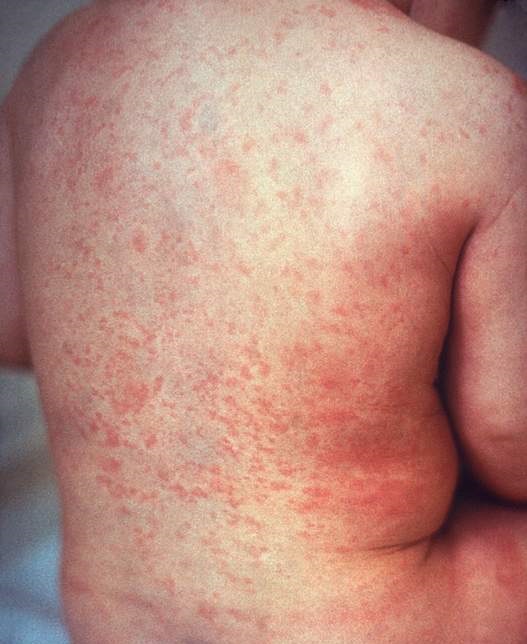
A diagnosis of rubella can be confirmed via a blood test by detecting the presence of antibodies to rubella. To detect the presence of rubella in a fetus, amniotic fluid or fetal blood can be tested for the virus.[43]
Treatment for nonpregnant clients suffering from rubella is supportive. NSAIDs may be used to manage fever and body aches. In those who are pregnant, management is determined by age of gestation at time of diagnosis. If diagnosed prior to 18 weeks of gestation, termination of the pregnancy may be suggested due to the high risk of birth defects. Immunoglobulins may be administered to induce passive immunity if pregnancy termination is not an option. If diagnosed after 18 weeks of gestation, additional monitoring of the pregnancy is needed. Clients diagnosed with rubella must also follow isolation procedures to prevent the spread of the disease.[44]
The most common complication of rubella is inflamed and achy joints, usually affecting the wrists, fingers, knees, and ankles. More rare complications consist of anemia; reduction in platelet count; and inflammation of the heart, liver, testicles, eyes, or brain.[45]
Rubella can be prevented with the administration of the MMR or MMRV (measles, mumps, rubella, varicella) combination vaccine.[46]
Read additional information about the MMR or MMRV vaccines on the Centers for Disease Control and Prevention web page.
Rubeola
Rubeola, commonly known as measles, is an acute, contagious viral illness that is preventable by vaccine. Although currently rare in the United States due to vaccination, outbreaks can occur due to contact with unvaccinated children or those from endemic areas. Clients at highest risk for contracting measles are children who are not vaccinated and adolescents who are pregnant.[47]
The measles virus is transmitted via respiratory droplets and/or close contact with infected individuals. When the virus is inhaled, it initially affects the respiratory tract but then spreads to lymph tissue, the bloodstream, and other organs.[48]
Clients infected with the measles virus present with cough, runny nose, conjunctivitis, cough, fever, and a skin rash. The rash will first appear on the face and then spread inferiorly. Koplik spots, or white raised bumps on the inside of the mouth, are a characteristic sign of measles, but they may not be present in every case. See Figure 15.14[49] for an image showing Koplik spots. Measles can also lead to suppression of the immune system, which puts the client at risk for other infections.[50]
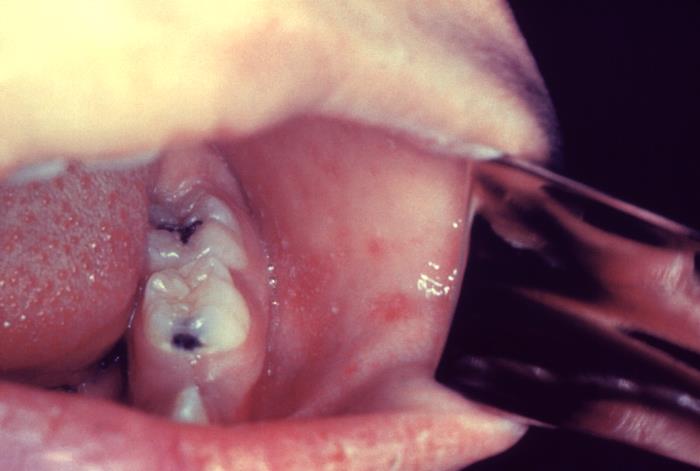
A diagnosis of measles can be confirmed by identifying the presence of measles antibodies in the blood. Clients with measles may also exhibit a reduction in white blood cells and platelets on a complete blood count. A PCR test can also be done on nose or throat secretions or urine samples to detect the presence of the virus.[51]
Treatment of measles consists of supportive care. Fever should be managed, and dehydration should be prevented or treated if present. Care must also be taken to prevent the spread of the virus. Uncomplicated cases usually conclude a week or so after the appearance of the rash.[52]
Complications may occur in infants, adolescents who are pregnant, and children who have poor nutrition or compromised immune systems. Common complications include pneumonia, ear infections that may lead to hearing loss, diarrhea, central nervous system disorders, and blindness. Pregnant females who contract measles are at risk for death, miscarriage, and delivering an infant with a reduced birth weight.[53]
Measles is preventable with the administration of a vaccine. Although it can be given as a stand-alone vaccine, it is commonly given as the Measles, Mumps, Rubella (MMR) combination vaccine.
Read additional information about the MMR vaccines on the Centers for Disease Control and Prevention web page.
Scarlet Fever
Scarlet fever is commonly associated with an untreated pharyngitis/tonsillitis infection caused by Group A beta-hemolytic streptococcus (GABHS) bacteria. However, scarlet fever can also occur if wounds or burns become infected with the bacteria. Clients at risk for scarlet fever are school-aged children, young children who have contact with school-aged children, and people living in undeveloped countries or crowded living areas. GABHS is easily transmitted by those in close contact with one another, such as in classrooms and daycare facilities.[54]
GABHS releases an endotoxin that causes the characteristic rash of scarlet fever. The release of this toxin also causes a localized inflammatory response on the skin. Common signs and symptoms of scarlet fever are sore throat (when associated with pharyngitis), high fever, swollen cervical lymph nodes, and a characteristic rash. The rash feels like sandpaper and begins under the arms, on the trunk, and in the groin and ultimately spreads to the extremities. A classic symptom of scarlet fever is a strawberry tongue, in which the tongue initially has a white coating and then appears red and bumpy. See Figure 15.15[55] for an image showing a strawberry tongue. As the rash begins to resolve, desquamation, or peeling of the skin may occur.[56]
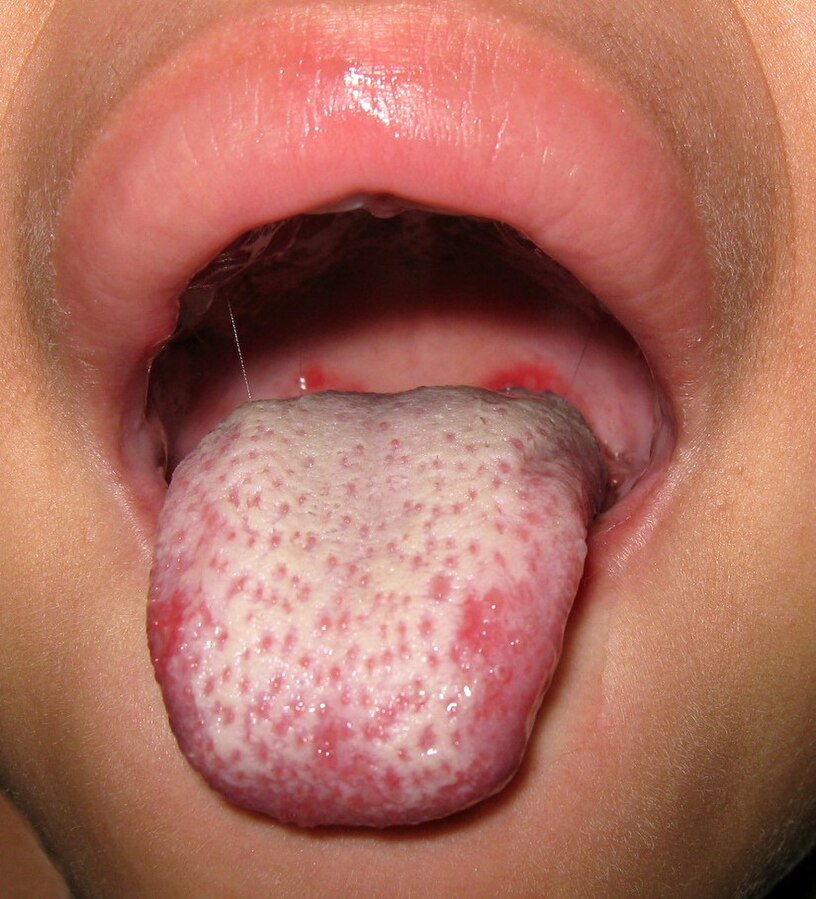
Scarlet fever is diagnosed by a throat culture or rapid strep test to determine if GABHS is present. Treatment of scarlet fever consists of antibiotics to destroy the GABHS bacteria. Clients should also be taught to use effective hand hygiene and respiratory etiquette and to avoid others while ill to prevent the spread of GABHS.[57] Clients should be taught they can return to normal activities 24 hours after initiation of antibiotics.
Although scarlet fever is considered a mild disease after the advent of antibiotic use, complications can develop when GABHS is not treated or if treatment is delayed. The original infection may spread from the throat to the ears or meninges, leading to bacterial meningitis.[58] Another complication called rheumatic fever is caused by the immune response after the original infection has resolved. Rheumatic fever causes long-term effects on the heart valve. Review the “Pharyngitis, Tonsillitis, & Adenoiditis” section of this chapter for more information on complications caused by GABHS.[59]
View the “Respiratory Alterations” chapter in Open RN Health Alterations for additional information on respiratory disorders such as chronic obstructive pulmonary disease, pneumonia, tuberculosis, lung cancer, and respiratory viruses such as influenza and COVID-19.
- Betts, J. G., Young, K. A., Wise, J. A., Johnson, E., Poe, B., Kruse, D. H., Korol, O., Johnson, J. E., Womble, M., & DeSaix, P. (2022). Anatomy and Physiology 2e. OpenStax. https://openstax.org/books/anatomy-and-physiology-2e/pages/1-introduction ↵
- “Asthma_attack-illustration_NIH.jpg” by United States-National Institutes of Health: National Heart, Lung, Blood Institute is in the Public Domain. ↵
- Betts, J. G., Young, K. A., Wise, J. A., Johnson, E., Poe, B., Kruse, D. H., Korol, O., Johnson, J. E., Womble, M., & DeSaix, P. (2022). Anatomy and Physiology 2e. OpenStax. https://openstax.org/books/anatomy-and-physiology-2e/pages/1-introduction ↵
- Chakraborty, R. K., Chen, R. J., & Basnet, S. (2024) Status asthmaticus. StatPearls [Internet]. https://www.ncbi.nlm.nih.gov/books/NBK526070/ ↵
- Betts, J. G., Young, K. A., Wise, J. A., Johnson, E., Poe, B., Kruse, D. H., Korol, O., Johnson, J. E., Womble, M., & DeSaix, P. (2022). Anatomy and Physiology 2e. OpenStax. https://openstax.org/books/anatomy-and-physiology-2e/pages/1-introduction ↵
- National Heart, Lung, and Blood Institute. (2023). Cystic fibrosis. https://www.nhlbi.nih.gov/health/cystic-fibrosis ↵
- National Heart, Lung, and Blood Institute. (2023). Cystic fibrosis. https://www.nhlbi.nih.gov/health/cystic-fibrosis ↵
- National Heart, Lung, and Blood Institute. (2023). Cystic fibrosis. https://www.nhlbi.nih.gov/health/cystic-fibrosis ↵
- Centers for Disease Control and Prevention. (2024). About cystic fibrosis. https://www.cdc.gov/cystic-fibrosis/about/index.html ↵
- Lamichhane, A., & Radhakrishnan, S. (2024). Diphtheria. StatPearls [Internet]. https://www.ncbi.nlm.nih.gov/books/NBK560911/ ↵
- Lamichhane, A., & Radhakrishnan, S. (2024). Diphtheria. StatPearls [Internet]. https://www.ncbi.nlm.nih.gov/books/NBK560911/ ↵
- “Dirty_white_pseudomembrane_classically_seen_in_diphtheria_2013-07-06_11-07” by Dileepunnikri is licensed under CC BY-SA 3.0 ↵
- Lamichhane, A., & Radhakrishnan, S. (2024). Diphtheria. StatPearls [Internet]. https://www.ncbi.nlm.nih.gov/books/NBK560911/ ↵
- Lamichhane, A., & Radhakrishnan, S. (2024). Diphtheria. StatPearls [Internet]. https://www.ncbi.nlm.nih.gov/books/NBK560911/ ↵
- Lamichhane, A., & Radhakrishnan, S. (2024). Diphtheria. StatPearls [Internet]. https://www.ncbi.nlm.nih.gov/books/NBK560911/ ↵
- Lamichhane, A., & Radhakrishnan, S. (2024.) Diphtheria. StatPearls [Internet]. https://www.ncbi.nlm.nih.gov/books/NBK560911/ ↵
- Davison, P., Rausch-Phung, E. A., & Morris, J. (2024). Mumps. StatPearls [Internet]. https://www.ncbi.nlm.nih.gov/books/NBK534785/ ↵
- Davison, P., Rausch-Phung, E. A., & Morris, J. (2024). Mumps. StatPearls [Internet]. https://www.ncbi.nlm.nih.gov/books/NBK534785/ ↵
- “Mumps_PHIL_130_lores” by CDC/Dr. Charles N. Farmer is in the Public Domain. ↵
- Davison, P., Rausch-Phung, E. A., & Morris, J. (2024). Mumps. StatPearls [Internet]. https://www.ncbi.nlm.nih.gov/books/NBK534785/ ↵
- Davison, P., Rausch-Phung, E. A., & Morris, J. (2024). Mumps. StatPearls [Internet]. https://www.ncbi.nlm.nih.gov/books/NBK534785/ ↵
- Davison, P., Rausch-Phung, E. A., & Morris, J. (2024). Mumps. StatPearls [Internet]. https://www.ncbi.nlm.nih.gov/books/NBK534785/ ↵
- Davison, P., Rausch-Phung, E. A., & Morris, J. (2024). Mumps. StatPearls [Internet]. https://www.ncbi.nlm.nih.gov/books/NBK534785/ ↵
- Davison, P., Rausch-Phung, E. A., & Morris, J. (2024). Mumps. StatPearls [Internet]. https://www.ncbi.nlm.nih.gov/books/NBK534785/ ↵
- Lauria, A. M., & Zabbo, C. P. (2022). Pertussis. StatPearls [Internet]. https://www.ncbi.nlm.nih.gov/books/NBK519008/ ↵
- Lauria, A. M., & Zabbo, C. P. (2022). Pertussis. StatPearls [Internet]. https://www.ncbi.nlm.nih.gov/books/NBK519008/ ↵
- Lauria, A. M., & Zabbo, C. P. (2022). Pertussis. StatPearls [Internet]. https://www.ncbi.nlm.nih.gov/books/NBK519008/ ↵
- U.S. Food and Drug Administration. (2022, April 25). What is that sound? Whooping cough [Video]. YouTube. All rights reserved. https://www.youtube.com/watch?v=DB70izafC1Y ↵
- Lauria, A. M., & Zabbo, C. P. (2022). Pertussis. StatPearls [Internet]. https://www.ncbi.nlm.nih.gov/books/NBK519008/ ↵
- Lauria, A. M., & Zabbo, C. P. (2022). Pertussis. StatPearls [Internet]. https://www.ncbi.nlm.nih.gov/books/NBK519008/ ↵
- Lauria, A. M., & Zabbo, C. P. (2022). Pertussis. StatPearls [Internet]. https://www.ncbi.nlm.nih.gov/books/NBK519008/ ↵
- Lauria, A. M., & Zabbo, C. P. (2022). Pertussis. StatPearls [Internet]. https://www.ncbi.nlm.nih.gov/books/NBK519008/ ↵
- Lauria, A. M., & Zabbo, C. P. (2022). Pertussis. StatPearls [Internet]. https://www.ncbi.nlm.nih.gov/books/NBK519008/ ↵
- Lauria, A. M., & Zabbo, C. P. (2022). Pertussis. StatPearls [Internet]. https://www.ncbi.nlm.nih.gov/books/NBK519008/ ↵
- Ramirez, J. A. (2023). Overview of community-acquired pneumonia in adults. UpToDate. https://www.uptodate.com ↵
- National Heart, Lung, and Blood Institute. (2022). What is pneumonia? https://www.nhlbi.nih.gov/health/pneumonia#:~:text=Pneumonia%20is%20an%20infection%20that,or%20fungi%20may%20cause%20pneumonia ↵
- American Lung Association. (2023). Pneumonia symptoms and diagnosis. https://www.lung.org/lung-health-diseases/lung-disease-lookup/pneumonia/symptoms-and-diagnosis ↵
- American Lung Association. (2023). Pneumonia symptoms and diagnosis. https://www.lung.org/lung-health-diseases/lung-disease-lookup/pneumonia/symptoms-and-diagnosis ↵
- Camejo Leonor, M., & Mendez, M. D. (2023). Rubella. StatPearls [Internet]. https://www.ncbi.nlm.nih.gov/books/NBK559040/ ↵
- Camejo Leonor, M., & Mendez, M. D. (2023). Rubella. StatPearls [Internet]. https://www.ncbi.nlm.nih.gov/books/NBK559040/ ↵
- Camejo Leonor, M., & Mendez, M. D. (2023). Rubella. StatPearls [Internet]. https://www.ncbi.nlm.nih.gov/books/NBK559040/ ↵
- “Rash_of_rubella_on_back_(crop)” by CDC is in the Public Domain. ↵
- Camejo Leonor, M., & Mendez, M. D. (2023). Rubella. StatPearls [Internet]. https://www.ncbi.nlm.nih.gov/books/NBK559040/ ↵
- Camejo Leonor, M., & Mendez, M. D. (2023). Rubella. StatPearls [Internet]. https://www.ncbi.nlm.nih.gov/books/NBK559040/ ↵
- Camejo Leonor, M., & Mendez, M. D. (2023). Rubella. StatPearls [Internet]. https://www.ncbi.nlm.nih.gov/books/NBK559040/ ↵
- Camejo Leonor, M., & Mendez, M. D. (2023). Rubella. StatPearls [Internet]. https://www.ncbi.nlm.nih.gov/books/NBK559040/ ↵
- Kondamudi, N. P., & Waymack, J. R. (2023). Measles. StatPearls [Internet]. https://www.ncbi.nlm.nih.gov/books/NBK448068/ ↵
- Kondamudi, N. P., & Waymack, J. R. (2023). Measles. StatPearls [Internet]. https://www.ncbi.nlm.nih.gov/books/NBK448068/ ↵
- “6111_lores” by CDC/ Heinz F. Eichenwald, MD is in the Public Domain. ↵
- Kondamudi, N. P., & Waymack, J. R. (2023). Measles. StatPearls [Internet]. https://www.ncbi.nlm.nih.gov/books/NBK448068/ ↵
- Kondamudi, N. P., & Waymack, J. R. (2023). Measles. StatPearls [Internet]. https://www.ncbi.nlm.nih.gov/books/NBK448068/ ↵
- Kondamudi, N. P., & Waymack, J. R. (2023). Measles. StatPearls [Internet]. https://www.ncbi.nlm.nih.gov/books/NBK448068/ ↵
- Kondamudi, N. P., & Waymack, J. R. (2023). Measles. StatPearls [Internet]. https://www.ncbi.nlm.nih.gov/books/NBK448068/ ↵
- Pardo, S., & Perera, T. B. (2023). Scarlet fever. StatPearls [Internet]. https://www.ncbi.nlm.nih.gov/books/NBK507889/ ↵
- “Stomatite_001” by Grook Da Oger is licensed under CC BY-SA 3.0 ↵
- Pardo, S., & Perera, T. B. (2023). Scarlet fever. StatPearls [Internet]. https://www.ncbi.nlm.nih.gov/books/NBK507889/ ↵
- Pardo, S., & Perera, T. B. (2023). Scarlet fever. StatPearls [Internet]. https://www.ncbi.nlm.nih.gov/books/NBK507889/ ↵
- Pardo, S., & Perera, T. B. (2023). Scarlet fever. StatPearls [Internet]. https://www.ncbi.nlm.nih.gov/books/NBK507889/ ↵
- Pardo, S., & Perera, T. B. (2023). Scarlet fever. StatPearls [Internet]. https://www.ncbi.nlm.nih.gov/books/NBK507889/ ↵
A common chronic respiratory condition that is characterized by episodes of inflammation and edema of the airways and bronchospasms that prevent air from entering the lungs.
A genetic disease that causes a faulty CFTR protein that affects the body’s cells, tissues, and glands that make mucus and sweat.
A preventable illness that is caused by the bacteria Corynebacterium diphtheria.
A contagious illness caused by paramyxovirus.
Inanimate objects that can spread disease to others when they are contaminated with an infectious organism.
Painful swelling of the parotid salivary glands.
Painful swelling of the testes.
Inflammation of the ovaries.
Also known as whooping cough, is a preventable and contagious respiratory disorder caused by the bacteria Bordetella pertussis or Bordetella parapertussis.
Pneumonia that occurs when food or liquid is breathed into the airways or lungs, instead of being swallowed.
Pneumonia that is diagnosed in someone in the community (not in a hospital).
Pneumonia that is diagnosed in someone during or following a stay in a health care setting.
Pneumonia that is diagnosed in someone who has been on a ventilator.
Also known as the German measles, is a contagious viral condition that affects children and adolescents who are not immune.
Commonly known as measles, is an acute, contagious viral illness that is preventable by vaccine.
White raised bumps on the inside of the mouth.
A disorder that affects the valves of the heart and is caused by an untreated strep infection.
The tongue initially has a white coating and then appears red and bumpy.
Peeling of the skin.

